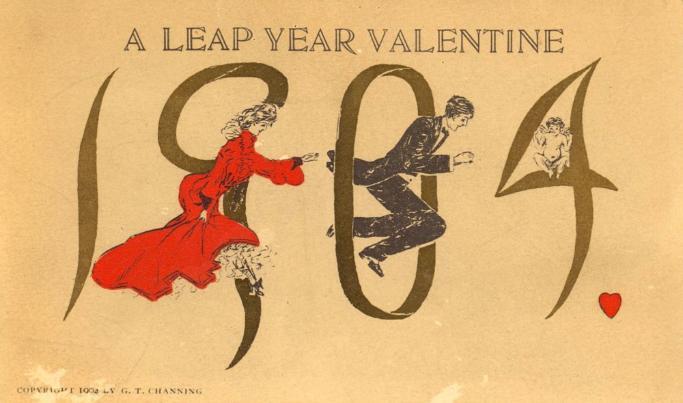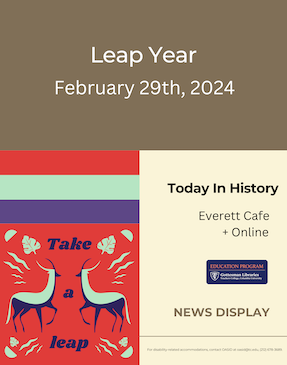Today In History: Leap Year

April, June, and November,
All the rest have thirty-one,
Save February at twenty-eight,
But leap year, coming once in four,
February then has one day more.
In a leap year, which occurs every four years, February has 29 days instead of the usual 28. The addition of one extra day serves to adjust time to compensate for a tropical year, when the Sun returns to the same position in the sky of a celestial body and completes its full cycle of seasons. While Roman Emperor Julius Caesar began the practice in 46 BCE, leap year, also known as "bissextile year" has an interesting history and custom; some say that Queen Margaret of Scotland, the last of the line of Scottish rulers descended from King Malcolm III Canmore and also known as "The Maid of Norway", decreed the day in 1288 to mark a woman's right to propose marriage. Considered for many years "a time of hope for maidens and a wary season for bachelors" Leap Year inspired many a romantic postcard or two, though superstition holds that it can actually be bad luck to marry on this particular day.
The following articles are drawn from Proquest Historical Newspapers, which informs and inspires classroom teaching and learning.
- Ladies' Column: Leap Year. (1880, Jan 31). The Times of India (1861-2010)
- Women's Leap Year PrivilegesL First Referred to in Records of Scottish History in the Thirteenth Century. (1896, Jul 11). Chicago Daily Tribune (1872-1922)
- She Started Leap Year: It Was Scotch Queen Margaret Who Urged Women's Rights--Old English Custom of the "Wedding House." (1899, Dec 31). Courier-Journal (1869-1922)
- Harcourt, H. (1908, Feb 02). The Borning of Leap Year: Interesting History That Shows How Time Was Made. Courier-Journal (1869-1922)
- Leap Year's Romance Is Woven of Threads From Many Sources: Both Myth and History Have Sometning to Say Upon Origin of Special Heart Interest. (1924, Jan 06). The Sun (1837-)
- Leap Year Keeps Alive Many Ancient Traditions: The Customs Which Concern "Ladies" Privilege Go Back to a a Dim Antiquity. (1928, Feb 05). New York Times (1923-)
- Mathematics of Leap Year Explained: History of Man's Efforts to Fit Time into a Calendar Traced From Chaldeans to Present Day. (1928, Mar 04). The Hartford Courant (1923-)
- Starnes, H. (1948, Feb 29). Leap Year on the Line: Leap Year. Chicago Daily Tribune (1923-1963)
- Leokum, A. (1970, Oct 16). Tell Me Why: When Did Leap Year Start? The Austin Statesman (1921-1973)
- Mehren, E. (1980, Feb 29). Liberation Grounding the Leap Year Tradition: Women's Right to Ask Is Now a 365-Day-a-Year Affair Liberation Grounding Leap Year. Los Angeles Times (1923-1995)

Tips:
- An Almanack for the Year of Our Lord 1660; Being First after Leap Year, and from the Creation 5609; Whose Vulgar Notes Are ... Calculated for the Longitude of 315 Gr. and 42 Gr. 30 Min. of N. Lat., and May Generally Serve for the Most Part of New-England, by S. C., Philomathemat. [i.e. Samuel Cheever]. Massachusetts: Printed for S. Green, 1660, 1954. e-book
- The Ladies Complete Pocketbook, for The Year of the Lord, 1758 Being The Second after Bissextile, or Leap-Year. The Thirty-First of King GEORGE II, and the Seventh of the New Style Used in Great Britain. London: Printed for T. Carnan, in St. Paul’s Church-Yard, [1758]. Closed Stacks Research ; AP3 .L345 1758
- Ruck, Berta. The Leap Year Girl. New York: Dodd, Mead, 1924, 1926. e-book
- Thompson, Sue Ellen. Holiday Symbols and Customs : A Guide to the Legend and Lore behind the Traditions, Rituals, Foods, Games, Animals, and Other Symbols and Activities Associated with Holidays and Holy Days, Feasts and Fasts, and Other Celebrations, Covering Ancient, Calendar, Religious, Historic, Folkloric, National, Promotional, and Sporting Events, as Observed in the United States and around the World. 5th ed. Detroit, MI: Omnigraphics, 2015. e-book
Image:
A Leap Year Valentine, c. 1904, Courtesy of the Library of Congress.
Need to keep current, look to the past, teach a topic? The Everett Cafe features daily postings of news from around the world, and also promotes awareness of historical events from an educational context. Be sure to check additional Cafe News postings on the library blog.

